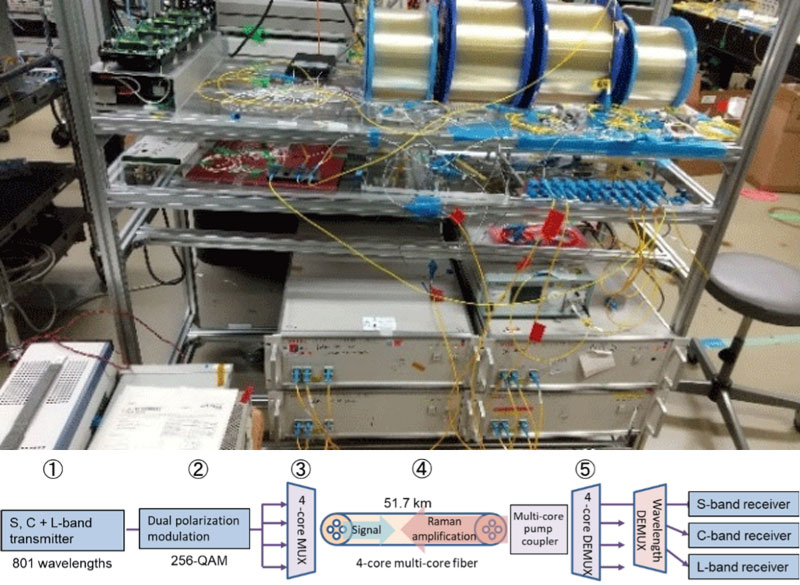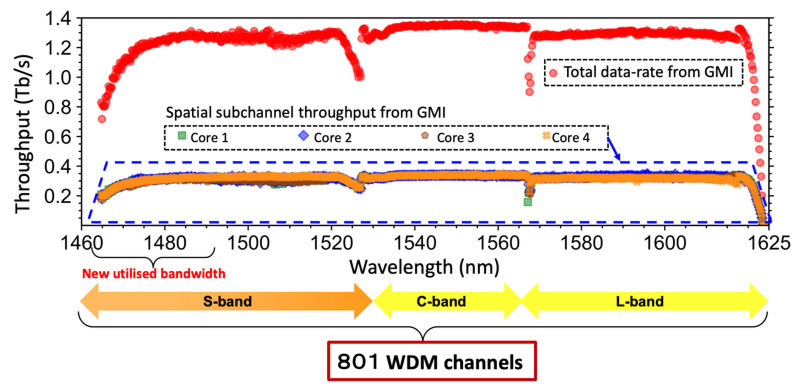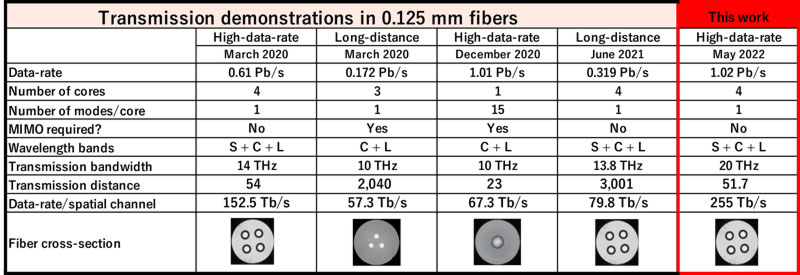Researchers Shatter Bandwidth Record Using Existing 4-Core Fiber Cables
This type of fiber is compatible with existing infrastructure.
Researchers at the National Institute of Information and Communications Technology (NICT) in Japan have achieved greater than 1 Petabit per second (Pb/s) data transfers using 4-core fiber with standard cladding. The key advance, facilitating this new transfer speed record, is the transmission system's support for optical bandwidth exceeding 20 THz. This beefy bandwidth comes largely thanks to the application of wavelength division multiplexing (WDM) technology and the deployment of the experimental S-band.
According to the NICT researchers, with this amount of bandwidth on tap you could broadcast 10 million 8K TV channels simultaneously.
One of the most important aspects of the headlining advance, achieving 1.02 Pbps data transfers, is that the cables used were compatible with existing infrastructure. Adhering to this specification, the technology will be able to be deployed in high-throughput and long-distance links sooner rather than later.
Previous attempts at high-data-rate transfers using the same optical fiber cabling, 125μm diameter 4-core MCF (Multi Core Fiber), peaked at 0.61 Pbps in tests by the same researchers back in March 2020. Now that greater than 1 Pbps transfers have been achieved with 4-core MCF, the research team can claim performance parity with more advanced 15-core fiber.
The push up from 0.61 to 1.02 Pb/s is mostly due to WDM technology. 'M' in this acronym stands for multiplexing, and record optical bandwidth exceeding 20 THz was achieved after multiplexing the already commercially adopted C- and L-transmission bands with recently explored S-band technology.
"Two kinds of doped fiber amplifiers along with Raman amplification with pumps added in a novel multi-core pump combiner, enabled transmission of 801 wavelength channels over the 20 THz optical bandwidth," explains the academic post.
The diagram above shows a summary of how the impressive bandwidth was achieved. Throughput is plotted against the wavelengths exploited – in 801 channels with 25 GHz spacing for high spectral density.
Get Tom's Hardware's best news and in-depth reviews, straight to your inbox.
In the diagram above we get a hint regarding the next step by NICT. Every time the researchers achieve a high data rate transfer milestone, they appear to follow up with work on a long-distance optimized fiber transmission technique. Thus we would expect, with some degree of confidence, that the 4-core MCF long-distance data rate record of 0.32 Pb/s (distance between 2,000 and 3,000km) will be broken in the coming months.

Mark Tyson is a news editor at Tom's Hardware. He enjoys covering the full breadth of PC tech; from business and semiconductor design to products approaching the edge of reason.
-
hotaru251 even if this was widely possibleReply
Comcast: Best I can do is 1gigabit and it'll cost ur left leg & ur upload is maxing at 20 mb
Still very impressive results -
spongiemaster Reply
If Comcast had an entirely fibre network, it wouldn't be asymmetric. The way the cable companies' infrastructure was built out for cable TV which didn't require high speed upload is why we are stuck with such wildly asymmetric upload/download speeds. To fix that issue would require pretty much everything except the cable itself to be replaced, which isn't happening.hotaru251 said:even if this was widely possible
Comcast: Best I can do is 1gigabit and it'll cost ur left leg & ur upload is maxing at 20 mb -
Reply
Regural people don't need symetric links. What for? If you do need it, then buy a business internet connection. Those are symmetrical and bandwidth is guaranteed.spongiemaster said:If Comcast had an entirely fibre network, it wouldn't be asymmetric. The way the cable companies' infrastructure was built out for cable TV which didn't require high speed upload is why we are stuck with such wildly asymmetric upload/download speeds. To fix that issue would require pretty much everything except the cable itself to be replaced, which isn't happening. -
Reply
50MB/s download --> 500Mbpshotaru251 said:even if this was widely possible
Comcast: Best I can do is 1gigabit and it'll cost ur left leg & ur upload is maxing at 20 mb
Still very impressive results
2MB/s upload --> 20Mbps
Why would I need higher upload. I don't stream or work remotely. Download is what I'm concerned with. Translates to how fast a game is downloaded from Steam, i.e.
Grab a business internet connection to have symmetrical links. Then again, can you afford it? -
escksu Replytommo1982 said:50MB/s download --> 500Mbps
2MB/s upload --> 20Mbps
Why would I need higher upload. I don't stream or work remotely. Download is what I'm concerned with. Translates to how fast a game is downloaded from Steam, i.e.
Grab a business internet connection to have symmetrical links. Then again, can you afford it?
It's x 8 instead of 10 for bytes to bits conversion. -
hotaru251 Reply
it was more at a jab that American ISP have no intention of giving ppl better speeds like rest of the world as there is no competition so they still make $ by being only option in area.spongiemaster said:If Comcast had an entirely fibre network, it wouldn't be asymmetric. The way the cable companies' infrastructure was built out for cable TV which didn't require high speed upload is why we are stuck with such wildly asymmetric upload/download speeds. To fix that issue would require pretty much everything except the cable itself to be replaced, which isn't happening. -
escksu Of course this won't be for consumers. No consumer systems can even hit anywhere close to that speed (your cpu can't even transfer data that fast).Reply -
w_barath ReplyAdmin said:According to the NICT researchers, with this amount of bandwidth on tap you could broadcast 10 million 8K TV channels simultaneously.
You're quoting NICT as having said they can broadcast 10M 8k TV channels?
Are they aware you of your speech on their behalf?
There exists no broadcast media through which you can deliver that density of information coherently.
I think you meant to quote them as saying they can transmit 10M 8k TV channels - in the context they announced it - on a closed 4-strand fibre link.
So I did your journalistic due diligence for you and here's the source of your misquote:
One petabit per second is equivalent to 10 million channels of 8K broadcasting per second.
https://www.nict.go.jp/en/press/2022/05/30-1.html
See the glossary section, which is not a claim on their part.


